Take the guesswork out of growing your most treasured plants with our best-selling Gritmix No.1 All Purpose. This mineral-rich substrate is tailored for serious growers seeking optimal drainage, mineral diversity, and excellent root support.
Perfect for cactus species with deep taproots like Ariocarpus, Astrophytum, and Lophophora, this all-purpose mix also provides a robust base for bonsai at any stage.
Features
-
Pre-blended, all-purpose mineral mix
-
Ideal for taproot cacti and bonsai
-
Superior drainage and aeration
-
Provides long-term structural support
-
Enhances root health and reduces compaction risk
-
Sold by weight – not volume
Why You Should Buy
Gritmix No.1 is designed with mineral-loving plants in mind, offering a natural structure that simulates arid, rocky environments. This unique composition fosters strong root development while minimizing the risks of overwatering and root rot. Whether you're cultivating rare cacti or refining a bonsai's root structure, this mix is the go-to choice trusted by expert growers. It’s a ready-to-use blend that supports healthy growth without the need for additional amendments.
Common Applications
-
Mature taproot cactus species
-
All bonsai types, young or established
-
Succulent growers seeking premium drainage
-
Arid plant species requiring mineral-based substrates
FAQs
What exactly is Gritmix No1 (Cactus Minerals)?
A ready-to-use, mineral-rich substrate designed for sharp drainage, airflow and long-term structure—ideal for deep-taproot cacti (Ariocarpus, Astrophytum, Lophophora), succulents and bonsai.
Is Gritmix No1 ready to use straight out of the bag?
Yep—no blending or pre-treatments needed. Tip in, pot up, done.
What’s in Gritmix No1?
A proprietary blend of inert mineral components (think grit, pumice, lava rock and similar). No peat or bark to get soggy and compact.
Is Gritmix No1 pH neutral?
Yes. It’s neutral and inert, so you control nutrition with your fertiliser program.
Why sell by weight, not volume?
Mineral media are dense; selling by weight keeps things consistent and honest across batches and particle sizes.
Who is the Gritmix No1 best for?
Taprooted and desert cacti, mineral-loving succulents, and bonsai at any stage where you want structure, oxygen and fast drainage.
Can I use Gritmix No1 for seedlings or very young plants?
It’s formulated for mature plants. For tiny seedlings, use a finer-graded mineral mix or sieve to reduce particle size.
Will Gritmix No1 help prevent root rot?
Big time. The fast drainage and airflow make it harder to overwater and easier for roots to stay healthy.
Do I need to add organic matter?
Not required. Many growers run it straight. If you prefer a touch of organic, blend ~10–30% quality compost or a cactus potting mix—lighter in humid/cool climates, a bit more in hot/dry spots.
What blend ratios do you recommend for different uses?
• Taproot cacti: 100% Gritmix or 90:10 (Gritmix:organic)
• General succulents: 80:20
• Bonsai in growth: 70–90% mineral depending on species and watering habits
Is Gritmix No1 suitable for Lophophora/peyote?
Yes—exactly the kind of mineral, free-draining substrate taprooted Lophophora appreciate.
How about Astrophytum and Ariocarpus?
Also yes. These genera respond well to gritty, open mixes with minimal fines—right in the Gritmix wheelhouse.
Can I use Gritmix No1 as a top dressing too?
Absolutely. It’s tidy, reduces algae/crust and discourages fungus gnats.
Do I need to rinse Gritmix No1 before use?
Not necessary. If you’re ultra-particular or want to reduce dust in indoor setups, a quick rinse is optional.
Does Gritmix No1 compact over time?
No. The mineral structure resists compaction and stays airy long term.
What pots work best with Gritmix No1?
Anything with a drainage hole. Terracotta is great for extra evaporation; plastic works fine if you water appropriately. Avoid cachepots with no holes.
Can I use Gritmix No1 in self-watering or wicking planters?
Not recommended for desert cacti/succulents—constant moisture defeats the point of a mineral mix.
Indoor or outdoor?
Both. Indoors, it keeps watering simple and clean. Outdoors, it handles heavy rain better than organic mixes—just ensure pots can drain freely.
How often should I water in Gritmix No1?
Water thoroughly, then let the pot go fully dry. Frequency depends on plant, pot, season and light—typically less often than organic mixes because this drains so fast.
Do I still need fertiliser?
Yes. It’s inert. Feed lightly during active growth (spring–summer). Pair with your preferred cactus/succulent fertiliser or organic amendments—just don’t clog the mix with fines.
Is Gritmix No1 okay for bonsai?
Yep. It gives great structure, oxygen and drainage. Adjust particle size/organic fraction to species and climate.
Can I mix in additional pumice, zeolite or perlite?
You can, but you usually won’t need to. If you want to tune water-holding, add a little pumice or zeolite; avoid soft fines that muddy the texture.
Will perlite float to the surface?
This blend leans on heavier minerals, so floating is minimal compared to perlite-heavy mixes.
Does Gritmix No1 attract fungus gnats?
Much less than peat/bark mixes. Keeping the top layer dry and using a mineral top dressing further discourages them.
Is Gritmix No1 pet-safe and non-toxic?
It’s inert mineral media without added pesticides or wetting agents. As with all substrates, keep out of reach of pets who might chew or swallow stones.
What about pH-sensitive species or limestone lovers?
Because it’s neutral and mineral-based, you can tailor feed and water (e.g., cal-mag or mild alkaline inputs) to accommodate limestone-tolerant species.
How do I repot into Gritmix from a peaty soil?
Gently tease off old soggy media, prune rotten roots, let callus if needed, then pot into Gritmix. First watering after repot should be light; resume normal watering once established.
Can I reuse Gritmix No1 after a plant dies or is harvested?
Yes—pick out roots, bake/steam or soak in hydrogen peroxide if you want to sterilise, then refresh with a small portion of new Gritmix.
How long does Gritmix No1 last?
Years. It doesn’t break down like bark-based soils, so structure stays stable.
Will Gritmix No1 change my watering schedule compared to potting soil?
Yes—you’ll water more thoroughly but less frequently. The pot dries evenly and faster, which is exactly what arid plants prefer.
Is Gritmix No1 good for columnar cacti in tall pots?
Perfect. Tall columns and deep pots need stable, well-aerated mineral structure so the root zone doesn’t sour.
Can I use Gritmix No1 with heat mats or under lights?
Yes. In high light/warm setups, the fast drying helps prevent overwatering while roots get plenty of oxygen.
Does Gritmix No1 work in very humid climates?
It shines there—stick to 100% mineral or very low organic additions and increase airflow.
Do I need a specific watering technique?
Soak the root ball fully, let excess drain, then wait until the mix is bone dry before repeating. Bottom watering is fine as long as you let it drain back out.
Any tips for first-timers switching to mineral media?
Use a pot with a drainage hole, resist “just in case” sips, and add a mineral top dressing. If a plant was in peat before, expect a short adjustment period.
What sizes are available and what should I buy?
1.5 kg and 4.5 kg bags. If you’re potting several medium succulents or a couple of larger cacti, go the bigger bag—you’ll use more mineral media than you expect.
Is Gritmix No1 dusty or messy to use indoors?
It’s cleaner than bark-heavy soils. A quick mist after potting settles any loose fines.
Can I combine Gritmix No1 with akadama or other bonsai aggregates?
Sure—advanced users sometimes blend akadama or similar to tune water retention for specific bonsai species. Keep the overall texture open and gritty.
What if my plant still wilts in Gritmix No1?
Check roots (previous rot), pot size (too big stays cool/damp), light (too little) and watering cadence (should be deep + dry-down). The substrate itself won’t smother roots.
Storage and shelf life?
Store sealed and dry. Minerals don’t expire—keep moisture out and it’s good indefinitely.


